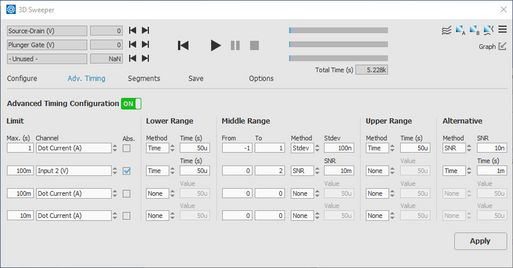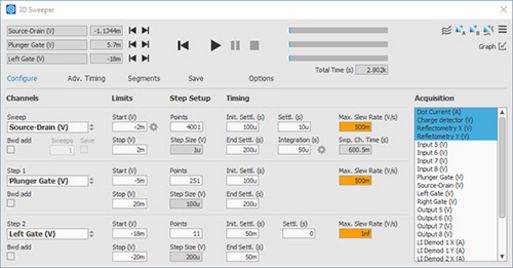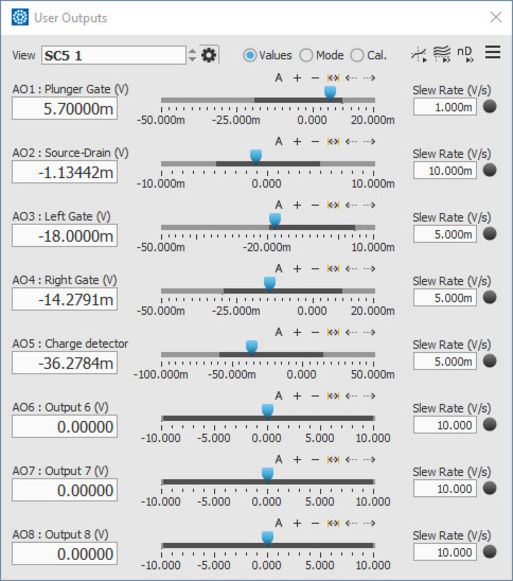
Software Handling
The Nanonis Tramea™ software is based on the latest developments in programming techniques and signal processing to provide a more powerful experimental platform. With its modular architecture and multi-window application all data are acquired simultaneously and transmitted to all software instruments at all times. Only the windows and functions necessary for the current experiment need to be open compared to an interface with a single window that often will have irrelevant sections displayed using valuable screen real estate. The window layout and settings can be stored and recalled at the click of a button for quick experiment switching.
Live Signals
Plenty of signals: Up to 24 Inputs, up to 48 outputs plus internal signals for a total of 128 signals, 24 of which are seamlessly accessible at the same time throughout the entire Nanonis software. Any signal can be selected in any module for observation, acquisition or noise analysis without affecting other modules. With the modular architecture, all data are acquired simultaneously and transmitted to all software instruments at all times. The distinction between inputs and outputs is blurred to provide a more powerful experimental platform. All operations between signals are performed in the digital domain with intuitive software control without the drawbacks of analog signal processing. Signals are displayed in physical units using a floating point representation with assigned SI units for immediate quantitative results. Up to 24 signals can be streamed directly to disk at full real-time speed, and for even higher time resolution, up to 8 signals at the ADC sampling rate of 1 MS/s can be streamed. So, acquiring a large number of simultaneous signals from a complex device at a high rate is now possible.
Ultrafast Precise Measurements
A typical transport measurement could take an enormous amount of time due to the limited speed of most measurement systems. With Nanonis Tramea™, these measurements can be performed in a matter of minutes instead of several hours: the core module of the Tramea software is a fast sweeper used to generate two- and three-dimensional sweeps, attaining speeds of up to 20’000 points per second on 24 channels in parallel.
For even higher rates, the latest high speed sweeper module can generate and acquire up to a million points per second opening the way to video-rate data display and acquisition. These impressive speeds are achieved while maintaining precision 20-bit performance!
That is faster by a factor of more than 1000x compared to current systems without any compromise in signal quality. Combine the speed of a waveform generator with the performance of a precision DC source.
Head to the Nanonis Tramea product page for more information
Intelligent adaptive oversampling

Nanonis Tramea™ adds an additional degree of intelligence to data acquisition: Measurement speed can be adapted automatically to the actual value and required quality of the input signal. This results in faster measurements
for intervals where no interesting input signal is expected (e.g. just noise) and in higher quality data for the measurement ranges of interest.
- User-selectable input ranges determine the speed of the measurement depending on the input signal value. Avoid spending precious measurement time when the signal is of no interest
- Intelligent adaptive oversampling* automatically adjusts measurement speed so that a target signal-to-noise ratio is achieved. This ensures maximum measurement speed for a required data quality
Both methods can be used in parallel on up to 4 input signals. The most restrictive condition determines measurement speed
*invented by P. Märki, Nanophysics group of Prof. K. Ensslin, ETH Zürich
Spectrum Analyzer, Graphs and Oscilloscopes
- Dual channel oscilloscope with post- and pre-trigger
- Spectrum analyzer: continuous display of any of the 128 channels
- Signal charts and history: rolling charts for continuous data monitoring and acquisition
- Long-term spectrum: record data over hours or days to discriminate environmental effects from the measurements.
All analyzers, graphs and oscilloscopes are completely independent and can run at the same time as data acquisition allowing the same channels to be acquired in the time- and frequency domain as well as in a conventional manner simultaneously. There is no need to have external diagnostic equipment or signal monitoring like oscilloscopes and spectrum analyzers, let Tramea be both the experimental data gatherer and diagnostic equipment for troubleshooting.
In addition to the modules of the base configuration, the optional 1MS/s high-resolution oscilloscope module offers 50x faster sampling rate and a considerably higher number of points per trace.
Signal Handling and Safety
Signal handling is designed to maximize productivity and emphasize safety of the sample at the same time.
- Slew-rate limitations and global voltage limits can be configured individually for each output to ensure that no transients or excess voltages are applied to the sample
- Linear combinations of output signals are easily configurable. Capacitive coupling between sample electrodes can easily be compensated
- All signals are displayed in physical units (SI). Calibrations take into account external divider or gain stages ensuring that the acquired data do not require any additional calibration
Easy Customization
One of the fascinating aspects of scientific research is that experiments have their own dynamics. That requires a high degree of flexibility from the measurement system.
Nanonis Tramea™ is sufficiently open to give researchers the necessary customization possibilities.
Remote control of a variety of preamplifiers including the Nanonis MCVA5, all Femto® variable gain amplifiers, the Basel Precision Instruments SP983c and the Pluto Instruments PCG-380F-R is possible. Gain control is accessible directly from the user inputs module and through an additional preamplifier control module in the case of the MCVA5. As standard within the Nanonis software, all calibrations are adjusted according to the configured gain, ensuring that data are acquired with the correct absolute value and do not require gain compensation in post-processing.Two DIO ports of the RC5 and RC5e can be used for remote control, as long as they are not used for other purposes. With the Nanonis MCVA5 that allows up to 8 channels of preamplification.
Simple control and readout of other external instruments is possible with the integrated External Devices module. This module allows control and readout of up to 4 parameters from external instruments (magnet power supplies, AWGs, RF sources, temperature controllers,...), as long as these have LabVIEW drivers. The Programming Interface add-on module is not required.
- Up to 4 input and 4 output instruments or parameters of the same instrument
- Sweep instruments and acquire data with the 1D-sweeper as well as use external equipment as the 3rd axis of the 3D-sweeper
- Display live data in the long-term chart
- Extremely simple driver configuration in LabVIEW
For full customization, the TCP Interface gives access to all Nanonis Tramea™ functions and signals from any programming environment:
- Generic TCP/IP interface allows control of most instrument functions as well as data readout
- Direct access to Tramea™ functions over a standarized interface
- Not bound to a specific programming language: Program Nanonis Tramea™ from Python, Matlab, C++ or other programming environments
A more comprehensive customization is possible with the LabVIEW Programming Interface add-on module.
Fast, time-deterministic customization with real-time feedback options is available through the Scripting add-on module.





